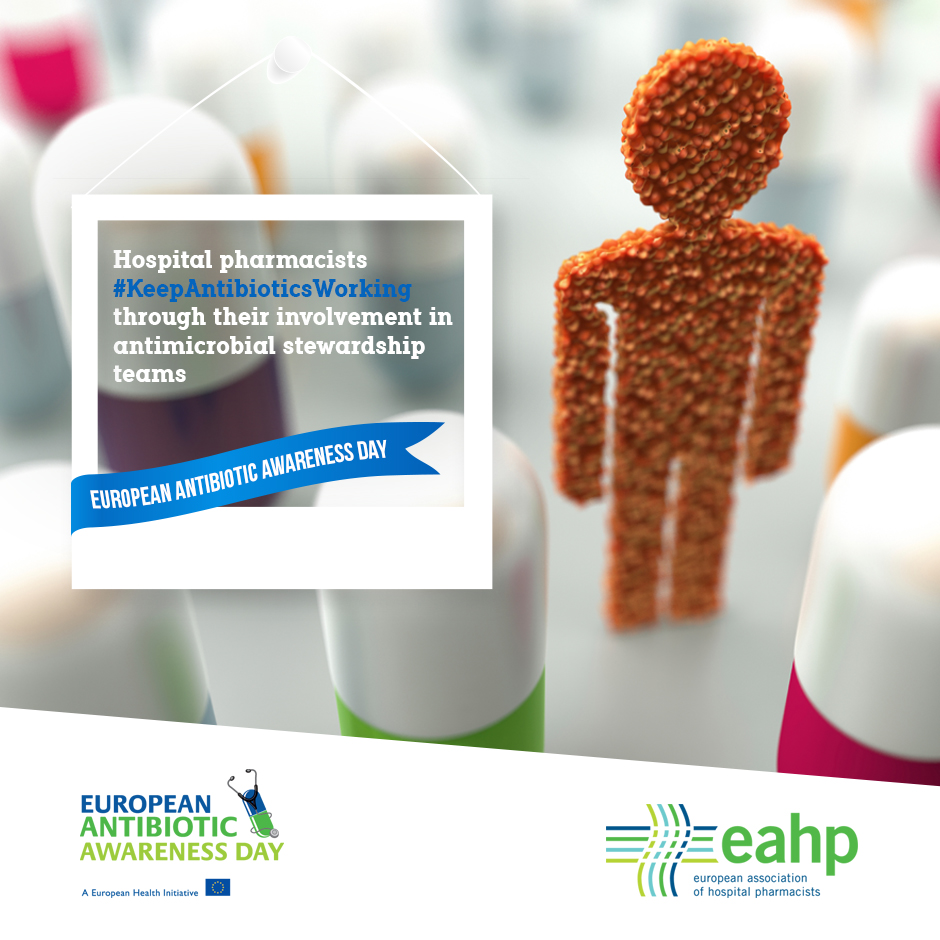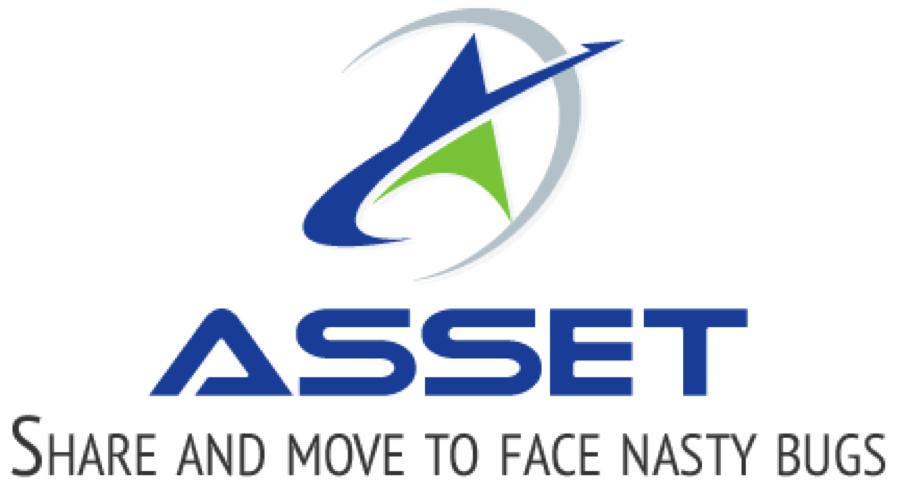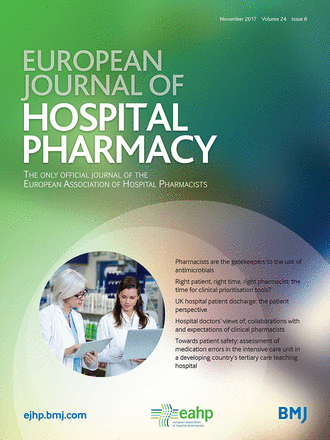EAHP EU Monitor - 27 November 2017
 The EAHP EU Monitor is a regular round up of news relevant to hospital pharmacy in Europe.
The EAHP EU Monitor is a regular round up of news relevant to hospital pharmacy in Europe.
You can subscribe to receive the EAHP EU Monitor by email HERE.

EAAD 2017 – Keeping antibiotics working
Like every year, the European Association of Hospital Pharmacists (EAHP) participated actively in the European Antibiotic Awareness Day (EAAD), an annual European public health initiative that takes place on 18 November to raise awareness about the threat to public health of antibiotic resistance and the importance of prudent antibiotic use. During this year's edition, the European Centre for Disease Prevention and Control (ECDC) focused on combined resistance to multiple antibiotics which has been identified as a growing problem in the EU.
The 10th anniversary of the EAAD which stood under the theme #KeepingAntibioticsWorking was used by ECDC to release its guidance on prevention and control of carbapenem-resistant Enterobacter iaceae (CRE), as well as its latest EU-wide data on antibiotic resistance
CRE, in which Escherichia coli and Klebsiella pneumoniae predominate, are responsible for a large number of patient deaths and high hospital costs. Patients who are "carriers" of CRE are considered "at-risk" for importing these multidrug-resistant bacteria into healthcare settings and spreading them to other patients. Consequently, a guidance was developed to assist frontline healthcare workers in identifying "at-risk" patients easily when admitted to a healthcare setting and implementing infection prevention and control (IPC) measures in a timely manner, on admission, to prevent CRE from spreading in the facility. Four risk factors that may put patients "at-risk" for carriage of CRE were identified:
- a history of an overnight stay in a healthcare setting in the last 12 months;
- dialysis dependence or cancer chemotherapy in the last 12 months;
- known previous carriage of CRE in the last 12 months; and
- epidemiological linkage to a known carrier of CRE.
If patients who are admitted to a healthcare setting are known CRE carriers or potential carriers, the guidance recommends preliminary supplemental measures such as pre-emptive isolation, active screening for CRE and contact precautions that should be implemented on admission.
The surveillance report showed that combined resistance to several antibiotic groups continued to grow. For Escherichia coli, combined resistance, measured as resistance to fluoroquinolones, third-generation cephalosporins and aminoglycosides, increased significantly between 2013 and 2016. Furthermore, in 2016, high percentages of Acinetobacter species isolates, with combined resistance to carbapenems, aminoglycosides and fluoroquinolones, were reported in southern and south-eastern Europe, as well as the Baltic countries.
Nonetheless, the report also noted that long-term efforts are slowly leading to positive results and helping to reverse the resistance trends. As an example, the overall resistance situation for Klebsiella pneumoniae seems to be stabilising in Europe, while the percentage of meticillin-resistant Staphylococcus aureus (MRSA) further decreased between 2013 and 2016. However, MRSA remains an issue as 10 out of 30 countries still report high percentages. The findings of the surveillance report are of great concern as patients infected with multidrug resistant bacteria have very limited treatment options.
In relation to the campaign #KeepingAntibioticsWorking EAAD stakeholder were invited to showcase how their contribution keeps antibiotics working. EAHP President-Elect Petr Horák remarked during his intervention at the EAAD event in Brussels which took place on 15th November 2017 that: "The guidelines and the evidence that has been called for during the event today need to be followed properly in the hospital. This encompasses not only gatekeeping measures that restrict the use of certain antibiotics, but also the provision of advice on the length and the need of an antibiotic therapy. Evidence has shown that the perspective and the expertise of hospital pharmacists, in particular in countries that have established the position of the antimicrobial pharmacists, leads to a more rational use of antibiotics in the successful treatment of the patient." His statement is supplemented by a video pledge of EAHP President Joan Peppard in which she highlighted how hospital pharmacists keep antibiotics working.
EAHP Video pledge HERE
Recording of the EAAD event in Brussels HERE
Latest data on antibiotic resistance HERE
Guidance on prevention and control of carbapenem-resistant Enterobacter iaceae HERE

News from the European Medicines Agency
During the last General Affairs Council meeting which took place on 20th November 2017, the EU27 ministers selected Amsterdam (the Netherlands) as the new seat of the European Medicines Agency (EMA). A relocation of the agency is necessary in the context of Brexit as the agency is currently hosted in London (United Kingdom). EMA has now 16 month to prepare its move, before it starts taking up its operation on 30th March 2019 at the latest.
Besides it's relocation, EMA has been working on a number of other initiatives including the review of flupirtine-containing and hydroxyethyl-starch containing medicines as well as the launch of a new EudraVigilance system.
Review of flupirtine-containing medicines started
The review of flupirtine-containing medicines for pain relief was requested by the German medicines authority, the Federal Institute for Drugs and Medical Devices (BfArM). It follows a previous EMA review in 2013 which introduced measures to restrict the use of these medicines because of reports of serious liver problems associated with their use.
As part of the measures from the earlier review, flupirtine use was limited to no more than 2 weeks in patients who could not use other pain treatments and tests of liver function were introduced before and during treatment. EMA also requested studies to show whether these restrictions were effective in reducing the risks. Results from some studies have now become available and suggest that, although the number of treated patients has gone down, the medicine is still being used outside the restrictions introduced in 2013. Furthermore, cases of serious liver damage associated with this medicine have continued to be reported.
EMA's Pharmacovigilance Risk Assessment Committee (PRAC) has therefore begun a further review to determine how the latest available data affects the balance of benefits and risks for these medicines and to decide whether additional regulatory action should be taken. While the review is ongoing, patients who have any concerns about their medication should speak to their doctor or pharmacist.
More information on the review HERE
More information on the European regulatory system for medicines HERE
Review of hydroxyethyl-starch containing medicines
Medicines containing hydroxyethyl-starch (HES) are used for the management of hypovolaemia (low blood volume) caused by acute (sudden) blood loss, where treatment with alternative infusion solutions known as 'crystalloids' alone is not considered to be sufficient. HES medicines are given by infusion (drip) into a vein and are used as blood volume expanders to prevent shock following acute bleeding.
The PRAC has started to the results of studies, and all other available data, and their impact on the benefit-risk balance of HES-containing medicines for infusion and issue a recommendation on whether their marketing authorisations should be maintained, varied, suspended or withdrawn across the EU. Input from stakeholders – such as healthcare professionals, patients' organisations, and the general public – that is relevant to this procedure will also be considered by PRAC.
More information on the review HERE
More information on HES containing medicinal products HERE
New EudraVigilance system is live
For better safety monitoring of patients across Europe, EMA has launched a new and improved version of EudraVigilance, the European information system of suspected adverse reactions to medicines that are authorised or being studied in clinical trials in the European Economic Area (EEA). The new system makes it easier for marketing authorisation holders and sponsors of clinical trials to report suspected adverse reactions and allows for better analysis of this information for the benefit of patient safety in Europe.
In comparison to the previous version, the new EudraVigilance offers simplified reporting of individual case safety reports, enhanced interoperability, better searchability, more efficient data analysis as well as increased system capacity to support large volumes of users and reports. Moreover, it aims at strengthening the collaboration with the World Health Organization (WHO) as EMA will make the reports of individual cases of suspected adverse reactions within the EEA directly available to the WHO Uppsala Monitoring Centre (UMC).
The reporting of adverse reactions by patients and healthcare professionals to national competent authorities based on local spontaneous reporting systems will remain unchanged. There will also be no changes to the reporting of suspected unexpected serious adverse reactions during clinical trials until the application of the new Clinical Trial Regulation. Public access to data held in EudraVigilance will be provided through the adrreports.eu portal, which includes new features for data retrieval and representation.
The Agency will continue to support national competent authorities, marketing authorisation holders and sponsors of clinical trials in the EEA through targeted e-learning and face-to-face trainings, webinars and information days.
More information on EudraVigilance HERE

Survey focusing on emergency and disaster pharmacy
In 2016, the International Pharmaceutical Federation (FIP) published pharmacy guidelines for responding to natural disasters which aim at helping pharmacists to prepare and manage natural disasters situations. Moreover FIP has issued statement of policy about role of the pharmacist in disaster management this year. Then, a survey is being conducted to determine how hospital pharmacies in Europe are prepared for a natural or manmade disaster and whether they have specifically followed these guidelines since their publications. Moreover, the survey tries to make an inventory of hospital pharmacies that already faced disaster situations and to collect information on how theses hospital pharmacies have managed the disaster situation.
This survey was initiated by Prof Pascal Bonnabry (Chief-pharmacist at the pharmacy of Geneva University Hospitals) and Dr Nicolas Widmer (Chief-pharmacist at thepharmacy of Eastern Vaud Hospitals), who have been mandated by the Swiss Confederation to develop a Centre for Emergency and Disaster Pharmacy at the University of Geneva, Switzerland. Its objectives are to offer research and teaching in this field.
Participation in the survey should not take more than 10-15 minutes to fill in case major events were not experienced in the last 5 years. For hospital pharmacies that were faced with a disaster situation the completion of the survey will take less than 30-40 minutes. All answers are welcome even if your hospital pharmacy doesn't have any special preparedness plan, since every answer is important to FIP.
Answers should be submitted by 22nd December 2017.
The survey can be accessed HERE
State of Health in the EU
 Last week, the European Commission published its 2017 companion report on the State of Health in the EU alongside the 28 country health profiles which assess the strengths and challenges of health systems in relation to the individual context and specificities of each EU country. Overall, the report highlights the need to rethink our health systems in order to ensure that they remain fit-for-purpose and provide patient-centred care.
Last week, the European Commission published its 2017 companion report on the State of Health in the EU alongside the 28 country health profiles which assess the strengths and challenges of health systems in relation to the individual context and specificities of each EU country. Overall, the report highlights the need to rethink our health systems in order to ensure that they remain fit-for-purpose and provide patient-centred care.
The State of Health in the EU is a two-year initiative undertaken by the European Commission that provides policy makers, interest groups, and health practitioners with factual, comparative data and insights into health and health systems in EU countries. The cycle is developed in cooperation with the Organisation for Economic Co-operation and Development (OECD) and the European Observatory on Health Systems and Policies.
The first part of the companion report proposes five ways to make healthcare effective, accessible and resilient. These suggestions include
- Health promotion and disease prevention to pave the way for a more effective and efficient health system;
- Strong primary care to guide patients through the health system and that helps to avoid wasteful spending;
- Integrated care which tackles a labyrinth of scattered health services to the benefit of the patient;
- Proactive workforce planning and forecasting to make health systems resilient to future evolutions;
- Patient-centred health data for policy and practice.
The second part of the report focuses on the key findings of the 28 country health profiles by summarising the overall findings for each EU Member State.
The EU's biennial companion report aims together with the 28 country health profiles at supplementing the picture drawn by Health at a Glance: Europe prepared by OECD. Following the presentation of the companion report to Health Ministries of all EU countries, national authorities can further discuss the above reports with the experts of the OECD and the European Observatory on Health Systems and Policies. The voluntary exchanges – which marks the end of the 2-year cycle of the State of Health initiative – will be able to take place from the beginning of 2018 and help Ministries to better understand the main challenges and develop the appropriate policy responses.
Video on the State of Health in the EU HERE
Companion report HERE
Country health profiles HERE
 ASSET stakeholder portal online
ASSET stakeholder portal online
The Action plan on Science in Society related issues in Epidemics and Total pandemics (ASSET), a European project which aims at improving the preparedness to the threat posed by pandemics (and epidemics) of infectious diseases has opened a Stakeholder Portal. By fostering better cooperation between science and civil society and by improving communication channels the ASSET project seeks to develop an integrated, transdisciplinary strategy, which will take place at different stages of the research cycle, combining local, regional and national levels.
The project has identified Responsible Research and Innovation (RRI) as well as public engagement as two increasingly important concepts in public health. To better align both the process and its outcomes with the values, needs and expectations of society not only open debates are required, but also the active participation of civil society in research and practical public health projects. Consequently, the ASSET project has decided to build a Stakeholder Portal where participants can discuss on these themes and report (if appropriate) their experiences.
The Stakeholder Portal exists in two versions: as a LinkedIn group and as a Facebook group, for a larger visibility. Participants that wish to join the LinkedIn group, the "Stakeholder Portal – ASSET Project" need to set up a LinkedIn account and request access to the group. Similarly, also for the participation in the Facebook group – the "Stakeholder Portal – ASSET Project" – a Facebook account is necessary. Anyone can view the discussion threads of the Facebook. However, in order to start a new discussion or comment on an existing one, membership to the group is required.
More information about the ASSET project HERE
EJHP: Audit of a multidisciplinary approach to improve management of community-acquired pneumonia
The online first edition of the European Journal of Hospital Pharmacy (EJHP) has published an original article focusing on community-acquired pneumonia, a frequent cause of morbidity, mortality and hospital admission worldwide. The article audits the adherence to standards of care, such as empirical prescribing of antibiotics, and evaluates the current multidisciplinary approach to the management of community-acquired pneumonia. Overall, the multidisciplinary approach has shown considerable compliance improvements.
More HERE
--------------------------------------------------------------

Consultations
EMA – Reflection paper on the use of extrapolation in the development of medicines for paediatrics
The reflection paper aims to provide guidance on the main regulatory requirements that are expected to be met for the evaluation of extrapolation approaches in development of medicines for children. However, indicating preferences for the use of particular quantitative methods to address specific objectives of paediatric development is not within the scope of this document. The principles outlined should encourage further exploration of potentially suitable methods for specific situations, and choice of strategies should be justified.
Deadline – 14th January - More information HERE
The reflection paper describes aspects that medicines developers may consider when designing medicines for older people, such as selecting appropriate routes of administration and dosage forms, dosing frequency, excipients, container closure systems, devices and technologies, and user instructions in the product information. It is intended to communicate the current status of discussions on the pharmaceutical development of medicines that may be used in the older population.
Deadline – 31st January 2018 - More information HERE
EMA – Concept paper on the need for a paediatric addendum of the guideline on clinical investigation of medicinal products for the treatment and prophylaxis of venous thromboembolic disease
A number of new EMA guidelines related to clinical investigation of medicinal products for the treatment and prophylaxis of venous thromboembolism (VTE) are already available, but recommendations are applicable only to adults. In contrast to adults, VTE in children is a rare event, but represents a significant management dilemma that requires therapeutic intervention. The concept paper thus has been drafted since a paediatric addendum to the guidelines on clinical investigation of medicinal products for the treatment and prophylaxis of VTE is considered necessary to discuss and make methodological recommendations adapted to children.
Deadline – 31st January 2018 - More information HERE
Commission – Public consultation on pharmaceutical in the environment
The consultation by the European Commission seeks views on possible actions to address the risks from pharmaceuticals in the environment. Its overall aim is to obtain views and information to support the development of the European Commission's strategic approach to pharmaceuticals in the environment.
Deadline – 21st February 2018 - Access survey HERE
EMA- Concept paper on the development of a reflection paper on new analytical methods/ technologies in the quality control of herbal medicinal products
Quality control is a prerequisite to assure safe and effective use of (traditional) herbal medicinal products, which are complex mixtures of numerous phytochemical constituents. For the majority of herbal substances, herbal preparations and (traditional) herbal medicinal products the active constituents are not known or are only partly understood. Consequently, EMA is planning to develop a reflection paper that addresses new analytical methods and technologies for the quality control of herbal medicinal products.
Deadline – 30th April 2018 - More information HERE




